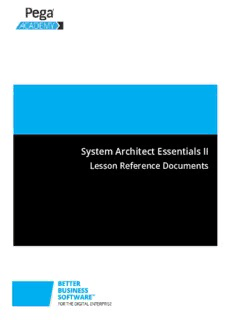Table Of ContentSystem Architect Essentials II
Lesson Reference Documents
Copyright 2014
Pegasystems Inc., Cambridge, MA
All rights reserved.
This document describes products and services of Pegasystems Inc. It may contain trade secrets and proprietary information.
The document and product are protected by copyright and distributed under licenses restricting their use, copying,
distribution, or transmittal in any form without prior written authorization of Pegasystems Inc.
This document is current as of the date of publication only. Changes in the document may be made from time to time at the
discretion of Pegasystems. This document remains the property of Pegasystems and must be returned to it upon request.
This document does not imply any commitment to offer or deliver the products or services provided.
This document may include references to Pegasystems product features that have not been licensed by your company. If you
have questions about whether a particular capability is included in your installation, please consult your Pegasystems service
consultant.
PegaRULES, Process Commander, SmartBPM® and the Pegasystems logo are trademarks or registered trademarks of
Pegasystems Inc. All other product names, logos and symbols may be registered trademarks of their respective owners.
Although Pegasystems Inc. strives for accuracy in its publications, any publication may contain inaccuracies or typographical
errors. This document or Help System could contain technical inaccuracies or typographical errors. Changes are periodically
added to the information herein. Pegasystems Inc. may make improvements and/or changes in the information described
herein at any time.
This document is the property of:
Pegasystems Inc.
1 Rogers Street
Cambridge, MA 02142
Phone: (617) 374-9600
Fax: (617) 374-9620
www.pega.com
Document Name: sae2_716_LessonReferenceDocuments_20141121.pdf
Date: 20141121
Table of Contents
Orientation........................................................................................................ 1
Course Overview................................................................................................................. 2
Effective Application Development with PRPC............................................. 7
HR Services Application Operational Walkthrough........................................................ 8
The Building Blocks of a PRPC Application....................................................................... 22
Managing the Building Blocks of a PRPC Application..................................................... 33
Guided Application Development Using Guardrails....................................................... 62
Designing Enterprise Applications Using Case Management.................... 73
Best Practices fsor Case Management Design................................................................ 74
Managing Enterprise Apps using Stage-Based Case Design.......................................... 100
Best Practices for Effective Case Decomposition............................................................ 129
Best Practices for Effective Process Decomposition....................................................... 174
Guardrails for Case Management Design........................................................................ 198
Creating an Effective Data Model.................................................................. 205
Best Practices for Designing a Data Model...................................................................... 206
Best Practices for Managing Data..................................................................................... 228
Best Practices for Managing Reference Data.................................................................. 241
Sharing Data Across Cases and Subcases........................................................................ 287
Guardrails for Data Models............................................................................................... 296
Integrating with External Data Sources......................................................... 302
Integrating with Databases................................................................................................ 303
Guardrails for Integrating with External Data Sources.................................................. 312
Creating Engaging User Experiences............................................................. 319
Designing the User Interface for Reuse and Maintainability......................................... 320
Building Assignment Focused (Intent-Driven) User Interfaces...................................... 337
Best Practices for Designing the User Interface.............................................................. 350
Using Advanced User Interface Controls......................................................................... 367
Managing Data for Selectable List Controls..................................................................... 376
Building Dynamic User Interfaces..................................................................................... 383
Validating User Input.......................................................................................................... 390
Guardrails for Creating Engaging User Experiences....................................................... 403
Enforcing Business Policies............................................................................. 409
Designing Business Rules for the Business User............................................................ 410
Enforcing Business Policies using Service Levels............................................................ 428
Notifying Users from Within a Process............................................................................. 445
Enforcing Business Policies Using Decision Rules........................................................... 465
Enforcing Data Relationships with Declarative Rules..................................................... 480
Guardrails for Enforcing Business Policies...................................................................... 496
Process Visibility Through Business Reporting............................................ 501
Preparing Your Data for Reporting................................................................................... 502
Building Business Reports................................................................................................. 512
Guardrails for Business Reporting.................................................................................... 524
Best Practices for Preparing an Application for Testing Deployment....... 532
Using Guardrail Reports to Ensure the Best Performance............................................ 533
Guidelines for Maintaining Requirements and Specifications...................................... 550
Module 01: Orientation
This lesson group includes the following lessons:
Course Overview
1
Course Overview
2
© 2014 Pegasystems Inc.
Course Overview
Welcome to the System Architect Essentials, Level Two course.
This course is designed for architects who have attended System Architect Essentials - Level
One,
or have a solid working knowledge of how to create a basic case type.
In this course, we assume you know how to create the necessary components to create a basic
case type using Pega 7 so our focus is on best practices and design patterns.
We’ll extend a previously built application to support additional case management requirements
and capabilities.
3
© 2014 Pegasystems Inc.
Course Overview
It will help to have some knowledge of –or experience with - object-oriented application design
and familiarity, or experience with agile project methodologies.
Knowledge of your company’s business practices and policies will also help you translate the
methods learned in this course to your “real world” requirements.
4
© 2014 Pegasystems Inc.
Course Overview
This course is organized into five broad categories.
We’ll start with case management design patterns.
Our goal here is to learn how to design case types that are easily communicated but contain
enough implementation detail to be executed directly –without modification.
Next, we’ll explore effective data management techniques and best practices
that make interacting with data, including data from external sources, more intuitive.
The third category is devoted to learning how to create an engaging user experience.
We’ll study best practices and learn how to use adavanced user interface controls.
Then, we’ll look at best practices for automating business policies.
Finally, we’ll cover how to provide business performance visibility through reporting.
5
© 2014 Pegasystems Inc.
Course Overview
Each lesson consists of a video and a transcript, and is presented as a case-study of a selected
business problem.
In the video we explore best practices for creating the most effective solution.
Almost every lesson has an exercise to help reinforce the case study and provide you hands-on
experience with Pega 7.
Each lesson includes a quiz to assess your knowledge of the topic.
Given that each lesson builds upon a previous lesson, we recommend that you take the lessons
in the order they are presented.
We look forward to helping you learn what Pega 7 has to offer and how it provides you the power
to simplify!
6
© 2014 Pegasystems Inc.
Description:We'll start with case management design patterns. Our goal here is to . The goal of System Architect Essentials II is to focus on design patterns and best practices when building stage-based or, maybe, simply, Construction.

